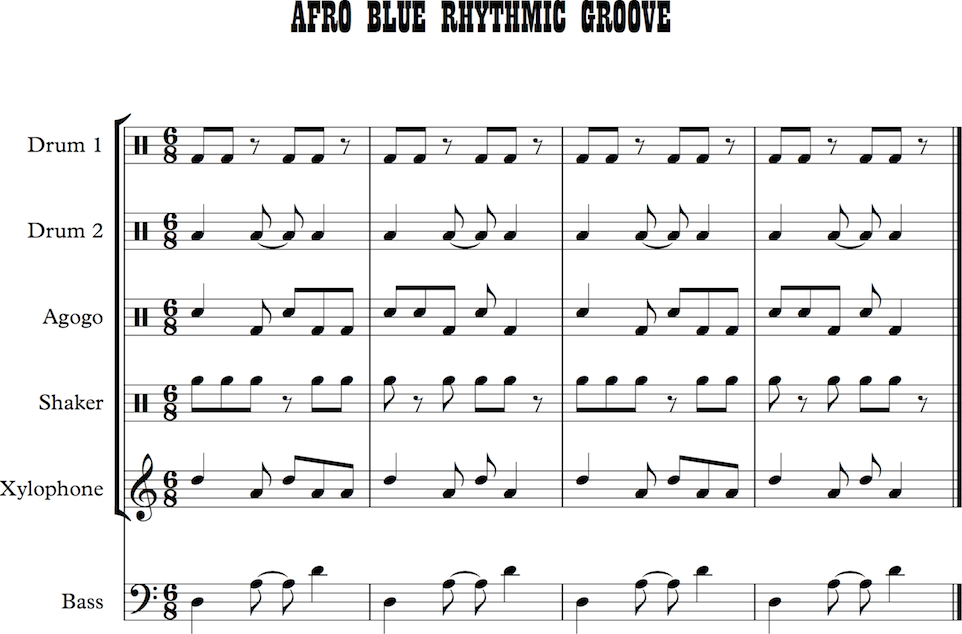
Exploring and Performing Afro-Cuban Rhythms
This lesson will introduce students to the history of Afro-Cuban music and one of Cuba’s most prominent composers and conga players named Ramon “Mongo” Santamaria. Focusing on Santamaria’s composition “Afro Blue," students will listen to and compare several recordings, then learn and perform a basic Afro-Cuban rhythmic groove. Create a PULSE account to view endless interactive contemporary music education materials.
Outcomes:
- Students will research and discuss the impact player Ramon “Mongo” Santamaria had on the evolution of Afro-Cuban music.
- Students will listen to various recordings of “Afro Blue” and discuss similarities and differences in interpretations.
- Students will demonstrate their understanding of the basic rhythmic groove of Afro Blue through learning and performing common Afro-Cuban rhythmic patterns.
Materials:
- Computer with a browser such as Chrome, Safari or Firefox, to access the Berklee PULSE website
- Projector, PA system
- Percussion instruments, non-pitched and pitched (or preferred instrument)
- Optional: One or a mix of the following: Manuscript paper, Notation software, a DAW
Suggested Online Resources:
Reading:
Listening:
PULSE Connections:
Assessment:
- Informal – class discussion and participation
- Formal – practice and performance of all rhythmic patterns presented in the lesson
INSTRUCTIONAL ACTIVITY IDEAS
Exposition of Material
1. Begin by showing the beginning clip of Zili Misik (00:00-01:47) After viewing the clip, analyze and discuss the following:
a. What do you notice about the rhythm? Are there repeated patterns? What kinds of rhythms are used most prominently (whole, half, quarter, eighth, sixteenth, triplets, etc.)? What instrument(s) drive the rhythmic feel of the song?
b. Describe the tempo.
c. What instruments are used in the song? Is the song sparse or dense?
Identifying Key Concepts and Terms
2. Using the suggested online readings above (or other materials selected by the teacher) present an overview of genres of music of the African diaspora and introduce students to the history of Afro-Cuban music.
a. Name and describe some forms of Cuban music.
b. Describe some characteristics of Afro-Cuban music.
3. Introduce students to Ramon “Mongo” Santamaria. Using the suggested online readings above (or other materials selected by the teacher), the teacher can present or students can research Santamaria’s contribution to Afro-Cuban music.
a. Where and when was he born?
b. How did he develop as a musician?
c. What were his most significant musical contributions?
4. Introduce students to the original recording of Santamaria’s composition “Afro Blue”. After listening, analyze and discuss the following:
a. What do you notice about the rhythm? Are there repeated patterns? What kinds of rhythms are used most prominently (whole, half, quarter, eighth, sixteenth, triplets, etc.)? What instrument(s) drive the rhythmic feel of the song?
b. Describe the tempo.
c. What instruments are used in the song?
d. Describe the melody.
5. Listen to other versions of “Afro Blue” (links to additional versions listed in suggested online listening resources above). Have students compare to the original Santamaria recording and discuss similarities and differences.
6. Listen again to the intro of Santamaria’s composition “Afro Blue” (0:00-0:26).
a. Discuss the time signature of 6/8.
b. Have students count and tap each beat.
Activity/Assessment
7. Analyze the various rhythmic patterns in the groove. Introduce each pattern separately and have students learn and perform each one separately.
a. This can be done using body percussion, various classroom percussion instruments, or instruments students have made.
b. Students can practice the rhythmic patterns along with the Santamaria recording, an audio file of the rhythmic groove (provided below), or a metronome.
Pattern 1

Pattern 2

Pattern 3

Pattern 4

Pattern 5

Pattern 6

8. Once students master each rhythmic pattern, put students in groups, assign parts and perform.
9. Have students switch parts so that they have the opportunity to play each rhythm in the groove.

Lesson Closing
1. Play the groove at different tempos.
2. Play the groove on pitched instruments.
3. Have each student in the ensemble improvise over the groove.
4. Add an original melody to the groove.
5. If students have access to a DAW, have them recreate the groove, then use it as a basis for an original composition.
6. Explore other Afro-Cuban rhythmic patterns and grooves.
7. Explore other Ramon “Mongo” Santamaria compositions, such as “Watermelon Man”.
8. Explore other genres of Cuban music.
Download the "Exploring and Performing Afro-Cuban Rhythms" Complete Lesson


